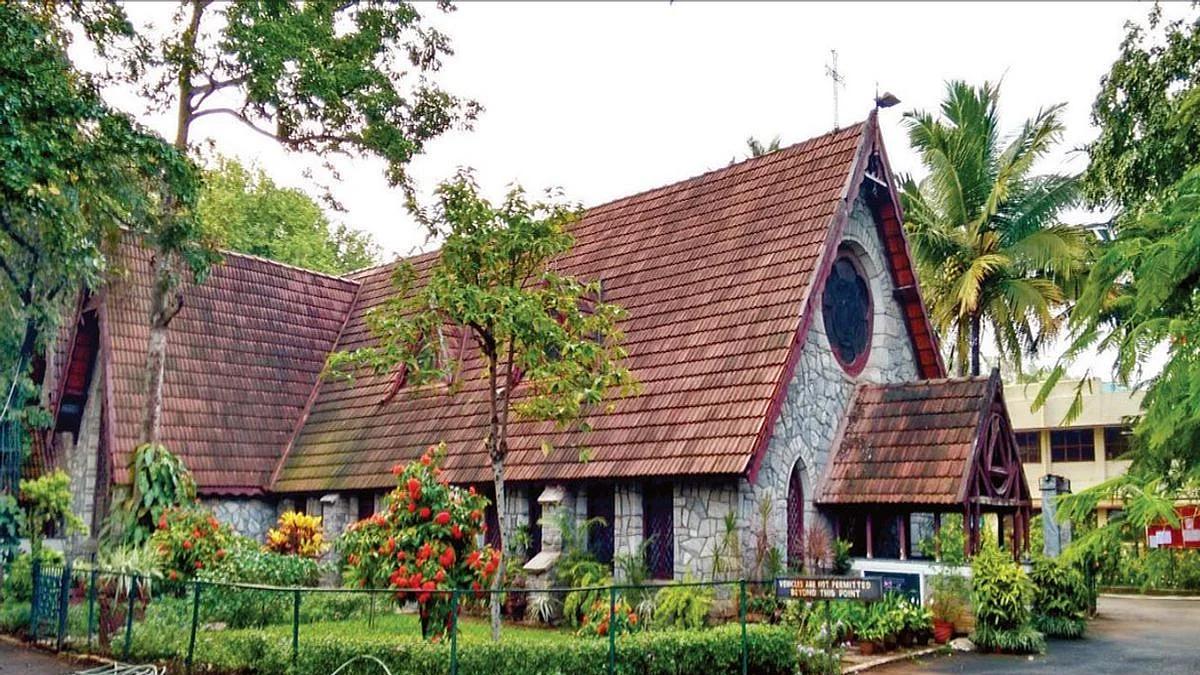End of road for 150-yr-old Bangalore Church?
The Church continues to stand peacefully in its grounds and awaits the settlement of the controversy to be able to celebrate its 150th birthday

Walking into the green campus of the All Saint’s Church on 1, Hosur Road, Richmond town, Bangalore, which lies at one of the busiest intersections in town, is like stepping into a time machine. Traffic noises fade away, muffled by the leaves and trailing branches of the over 100 trees – some over 150 years old – that fill the space. A lawn glows green under the sun-dappled shade. The quaint, steeply-gabled, tiled church with rubble stone masonry walls rising just seven feet to meet the roof, the typical arched windows transport you into an earlier century. As you step into the carpeted interiors, the roof, resting on artistically-wrought iron trusses, attracts the eye upwards, the carved teak pews, woodwork, the pipe organ – all take us to a time when the world was a calmer, more serene place. The air is filled with birdcalls of dozens of the species, some rare, which live in the precincts. Church records say that the land was gifted by the Maharaja of Mysore, Chamaraja Wodeyar, and later expanded to include space for an orphanage.
It was completed in 1870 by Rev. Samuel Pettigrew who was an important institution builder in Bangalore those days. He was the chaplain at St. Mark’s Cathedral at the time, and also warden of the Bishop Cotton Boy’s School. Estimated to cost Rs 10,000, its original design was rejected by the Church Building Society of Madras, as being unsuitable for a church and too small. The present building was then designed by well-known government architect Robert Chisholm, who is famous for pioneering the Indo-Saracenic style of architecture, which incorporates Indo-Islamic decorative and design elements with western styles. But All Saint’s Church has none of those elements in its design. Two earlier ones submitted by Chisholm were rejected and only the third was accepted. Rev. Pettigrew for his part struggled to collect the funds for its construction. The foundation stone was finally laid down in 1869.
The church has entered its 150th anniversary year in November, 2019, under the threat of large portions of its grounds, with over 100 trees, an old-age home, and a school for special children being lost to the Bangalore Metro Rail Corporation Limited (BMRCL) which has laid claim to them for constructing an underground metro station. There were plans to have a year-long commemoration but these activities are now on hold for several reasons.
The controversy has many dimensions. The management of the Church of South India (CSI), under which the All Saint’s church falls, consented to hand over the land, but the takeover has been fiercely resisted by a group of the members who have been part of the church for several generations, joined by Bangalore’s heritage lovers and environmental activists who have successfully staved off, temporarily, the take-over of the land which was imminent. They approached the funders, the European Investment Bank (EIB), with evidence that this was not a part of the original master plan, according to which Metro line ran right under the existing Hosur road, an arterial highway connecting Bangalore with Tamil Nadu.
The BMRCL claims the plan does not envisage any take over of the church land. But would a fragile 150-year-old rubble walled building roofed with tiles and wood survive the vibrations caused by the underground blasts that will precede the construction of the underground station, just a few feet away from it? Quite apart from the invaluable heritage aspect and the sensitive matter of interfering with the right to worship of several generations of Christians — the church now has over 500 families as members, who fill the pews and overflow into the gardens during worship. The members are at pains to explain that they are not against either the Metro or any other project designed to be of benefit to the public. They point out that the BMRCL has actually deviated from its original plan which did not affect their church or its land at all. They have suggested workable alternatives to the BMRCL, they say. There is speculation that the real reason is for the BMRCL to acquire hard-to-get real estate for commercial exploitation under this ruse, and hence the hard stance being taken by the BMRCL.
To add to this, the Defence Estate Department has entered the fray and says that as (probably a part of) the land was originally leased out to the Church by the Army, they were the original title holders and the land could not be alienated without their say-so, though they had no issues with the Church continuing to exist as originally planned.
The BMRCL had transferred several crores to the CSI as compensation for the land and now the Karnataka Industrial Areas Development Board has approached the bank to freeze the account into which the money had been transferred. As of now, the bank account continues to be frozen.
The congregation continues to protest, and on December 8, they completed 200 days of agitation to keep their Church undisturbed. They sought permission to have a human chain and a peaceful protest at their location but this was denied. They are trying to organise a meeting and find an amicable and workable solution to the stalemate.
The Church continues to stand peacefully in its grounds and awaits the settlement of the controversy to be able to celebrate its 150th birthday. Will this happen, or will it be yet another casualty of the urban development juggernaut that Bangalore is facing?
Follow us on: Facebook, Twitter, Google News, Instagram
Join our official telegram channel (@nationalherald) and stay updated with the latest headlines
